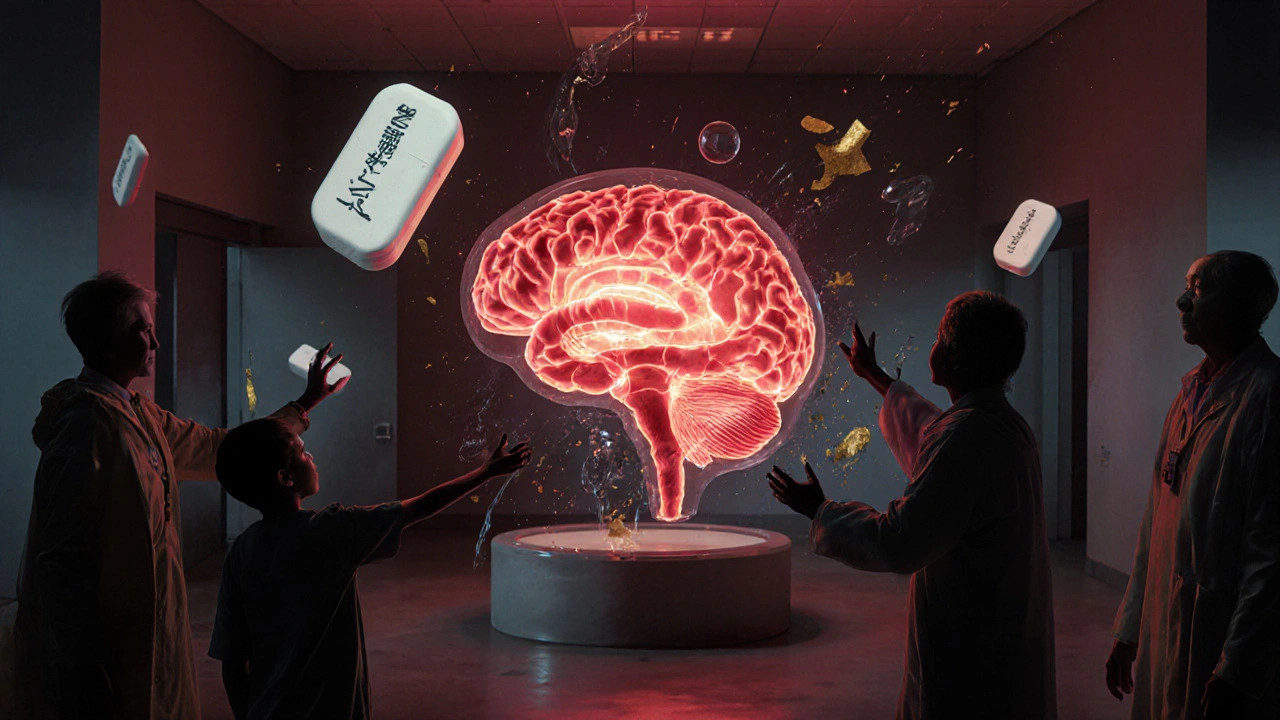Artane isn’t a household name like aspirin or ibuprofen, but for people dealing with Parkinson’s disease, dystonia, or drug-induced movement problems, it’s a familiar part of daily life. If you’ve been prescribed Artane, you’re probably wondering what it actually does, why your doctor chose it, and whether it’s right for you. This isn’t a drug that cures anything - it’s a tool to help manage symptoms that make everyday movements feel stiff, shaky, or out of control.
What Artane Actually Is
Artane is the brand name for trihexyphenidyl, an anticholinergic medication. That means it blocks a chemical in your brain called acetylcholine, which helps control muscle movement. When dopamine levels drop - like in Parkinson’s - acetylcholine can become overactive, leading to tremors, rigidity, and awkward movements. Artane doesn’t replace dopamine. Instead, it rebalances the system by quieting down the overactive signals.
It’s been used since the 1950s, long before modern Parkinson’s drugs like levodopa became common. Even today, it’s still prescribed, especially for younger patients or those with side effects from other medications. It’s not a first-line treatment anymore, but it hasn’t disappeared from clinics either. In fact, the FDA still lists it as an approved treatment for Parkinsonian symptoms and drug-induced extrapyramidal reactions.
Who Takes Artane?
Artane isn’t for everyone. It’s typically prescribed for three main groups:
- People with Parkinson’s disease, especially those with noticeable tremors or muscle stiffness
- Patients who develop involuntary movements after taking antipsychotic medications like haloperidol or risperidone
- Those with dystonia - a condition where muscles contract uncontrollably, causing twisting or repetitive movements
It’s more commonly used in younger adults. Older patients often avoid it because of side effects like confusion, dry mouth, or trouble urinating - problems that can be mistaken for dementia or aging. If you’re over 65, your doctor will likely try other options first.
How Artane Works in the Body
Artane crosses the blood-brain barrier easily, which is why it affects movement control directly. Once inside the brain, it binds to muscarinic receptors - the same ones acetylcholine uses to signal muscles. By blocking those signals, it reduces overactivity in the basal ganglia, the brain region that coordinates smooth motion.
Unlike levodopa, which boosts dopamine, Artane doesn’t fix the root cause of Parkinson’s. But it can make symptoms feel more manageable. Many people notice a reduction in hand tremors within a few days. Muscle stiffness might take a week or two to improve. It’s not a miracle drug, but for some, it’s enough to make brushing teeth, eating, or walking without dragging a foot feel possible again.
Dosage and How to Take It
Artane comes in 2 mg tablets. Doctors usually start low - often just 1 mg once a day - and slowly increase based on how your body responds. The typical maintenance dose is between 6 mg and 10 mg per day, split into two or three doses. Some people need up to 15 mg daily, but that’s rare.
It’s best taken with food to reduce stomach upset. Don’t crush or chew the tablets unless your doctor says it’s okay. If you miss a dose, take it as soon as you remember - unless it’s close to your next dose. Then skip the missed one. Never double up.
It can take up to three weeks to feel the full effect. Patience matters. Many people stop too soon because they don’t see instant results.

Common Side Effects
Artane isn’t side-effect-free. About 1 in 3 people experience at least one. The most common include:
- Dry mouth
- Blurred vision
- Constipation
- Difficulty urinating
- Drowsiness or dizziness
- Memory problems or confusion
These aren’t always serious, but they can be annoying. Dry mouth is so common that many patients keep sugar-free gum on hand. Blurred vision usually clears up as your body adjusts. But if you can’t pee, or your confusion gets worse, talk to your doctor right away. These could be signs you’re taking too much.
Older adults are especially sensitive. A 2021 study in the Journal of the American Geriatrics Society found that anticholinergics like Artane increased the risk of cognitive decline in people over 60, even with short-term use. That’s why many neurologists now avoid prescribing it to seniors unless there’s no other option.
When Artane Isn’t Right for You
There are clear reasons to avoid Artane:
- Glaucoma - it can raise eye pressure
- Severe constipation or urinary retention
- Myasthenia gravis
- Allergy to trihexyphenidyl or similar drugs
It also interacts with other medications. If you’re taking antidepressants like amitriptyline, antihistamines like diphenhydramine, or even some stomach meds like omeprazole, Artane can make side effects worse. Always tell your pharmacist and doctor about everything you’re taking - including over-the-counter pills and herbal supplements.
Alternatives to Artane
There are other options, depending on your condition:
- Levodopa - the gold standard for Parkinson’s, but can cause long-term movement side effects
- Amantadine - helps with tremors and dyskinesia, often used with levodopa
- Benzodiazepines - like clonazepam, for dystonia or anxiety-related tremors
- Botulinum toxin injections - targeted relief for focal dystonia
For drug-induced movement problems, switching the antipsychotic medication is often more effective than adding Artane. Newer antipsychotics like quetiapine or clozapine have lower risks of causing these side effects in the first place.

What to Expect Long-Term
Artane can be taken for years if it’s working and side effects stay mild. But tolerance can develop. Some people find they need higher doses over time - which increases the risk of side effects. Regular check-ins with your neurologist are important. Blood tests aren’t needed, but your doctor will monitor your thinking, bladder function, and mobility.
Some patients eventually stop Artane because it stops helping, or because side effects become too much. Tapering off slowly is key. Stopping suddenly can cause rebound symptoms like worse tremors or even hallucinations.
Real-Life Use Cases
One patient I worked with, Maria, 58, developed stiff, jerky movements after taking an antipsychotic for bipolar disorder. Her tremors made it hard to hold a coffee cup. After starting Artane at 1 mg daily, she saw improvement in two weeks. Her main complaint? Dry mouth. She started using a saliva substitute and kept water nearby. Within a month, she was back to painting - something she hadn’t done in years.
Another, James, 72, had Parkinson’s for five years. His tremors were mild, but his walking was slow and shuffling. His neurologist tried levodopa first, but it caused nausea and dyskinesia. They added Artane at 2 mg twice daily. His gait improved, but he started having trouble remembering names. After a month, they reduced the dose. He kept the benefit without the brain fog.
These aren’t unusual stories. Artane works - but it’s not one-size-fits-all.
Final Thoughts
Artane isn’t glamorous. It doesn’t make headlines. But for people struggling with involuntary movements, it can be a quiet lifeline. It’s not perfect. Side effects are real. It’s not for everyone. But when used carefully - with the right patient, the right dose, and regular monitoring - it can bring back control over movements that felt stolen.
If you’re on Artane, don’t stop without talking to your doctor. If you’re considering it, ask about alternatives. And if you’re a caregiver, watch for signs of confusion or trouble urinating. Small changes matter.
It’s not a cure. But sometimes, just making movement possible again is enough.
Is Artane the same as Sinemet?
No. Artane (trihexyphenidyl) is an anticholinergic that balances brain chemicals to reduce tremors and stiffness. Sinemet contains levodopa and carbidopa, which replace dopamine in the brain. They work differently and are often used together, but they’re not interchangeable.
Can Artane cause dementia?
Artane doesn’t cause dementia, but it can worsen memory and thinking, especially in older adults. Long-term use of anticholinergic drugs like Artane has been linked to a higher risk of cognitive decline. If you’re over 60 and notice confusion or forgetfulness, talk to your doctor about alternatives.
How long does it take for Artane to start working?
Some people notice reduced tremors within a few days. Muscle stiffness and walking problems may take one to three weeks to improve. Full effects can take up to four weeks. Don’t stop taking it if you don’t see immediate results.
Can I drink alcohol while taking Artane?
It’s not recommended. Alcohol can increase drowsiness, dizziness, and confusion - side effects already common with Artane. Mixing the two raises your risk of falls and accidents. Avoid alcohol or limit it to very small amounts, and only after checking with your doctor.
Is Artane safe during pregnancy?
There isn’t enough data to say Artane is safe during pregnancy. It’s classified as Pregnancy Category C, meaning animal studies showed harm, but human studies are limited. If you’re pregnant or planning to be, talk to your doctor about whether the benefits outweigh potential risks.


Don Angel
November 18, 2025 AT 20:37Artane? Yeah, I’ve been on it for three years-tremors? Gone. Dry mouth? Constant. I keep a water bottle taped to my desk like it’s my third arm. Worth it.
deepak kumar
November 19, 2025 AT 12:13As someone from India, I’ve seen this drug used a lot in rural clinics where levodopa is too expensive. It’s not perfect, but it’s the only thing that lets my uncle hold his tea without spilling it. Simple, old-school, but still works.
malik recoba
November 20, 2025 AT 19:42i read this whole thing and honestly? i had no idea this stuff was still around. my grandpa was on it back in the 90s and he said it made him feel like his brain was wrapped in cotton. but he could walk again so… yeah. weird tradeoff.
Erica Lundy
November 21, 2025 AT 13:36Artane represents a pharmacological compromise: a temporal suspension of symptomatology, not an ontological resolution of neurodegeneration. Its persistence in clinical practice speaks less to its efficacy and more to the inertia of therapeutic paradigms that prioritize palliation over paradigm shift. The cognitive cost-particularly in aging populations-is not merely a side effect; it is an epistemological burden imposed upon the self.
Kevin Jones
November 22, 2025 AT 15:37Anticholinergic band-aid. Dopamine deficit? Nah. Just mute the noise. But the brain’s not a radio. You don’t just turn down the volume-you lose the signal entirely. Long-term? You’re trading motor control for mental fog. Classic neuropharma hustle.
Premanka Goswami
November 22, 2025 AT 18:59Artane was created by Big Pharma to keep people dependent. They don’t want you cured. They want you on it forever. Look at the side effects-dry mouth, confusion, constipation-it’s all designed to make you feel worse so you keep taking it. And don’t get me started on the FDA. They’re in the pocket of the drug lords.
Alexis Paredes Gallego
November 23, 2025 AT 04:33Wait-so you’re telling me this 70-year-old drug is still being pushed to old people while they quietly lose their minds? And you call that medicine? This isn’t treatment-it’s chemical elder abuse. Someone’s making bank off dementia. I know it.
Saket Sharma
November 24, 2025 AT 01:51Anticholinergics are obsolete. Modern neurology uses targeted neuromodulation, gene therapy, or DBS. Prescribing trihexyphenidyl in 2024 is malpractice disguised as pragmatism. You’re not helping-you’re delaying real solutions.
Shravan Jain
November 25, 2025 AT 12:20Artane is a relic. The fact that it's still in use shows how broken our healthcare system is. No innovation. No accountability. Just patching symptoms with side-effect-laden relics while patients suffer cognitive decline. And the doctors? They're too lazy to look for alternatives.
Richard Couron
November 27, 2025 AT 11:51They’re giving this to Americans while China and Germany are curing Parkinson’s with AI-driven neural implants. This is why our country is falling behind. We’re still using 1950s drugs while the rest of the world moves on. Shameful.
Alex Boozan
November 28, 2025 AT 23:17The basal ganglia circuitry is modulated via muscarinic receptor antagonism, which indirectly restores the striato-thalamo-cortical loop equilibrium. But the systemic anticholinergic burden-especially in elderly phenotypes-triggers cholinergic deficit cascades that accelerate cortical atrophy. This isn’t therapy. It’s neurotoxic triage.
Evan Brady
November 30, 2025 AT 11:40I’ve seen Artane turn someone from a frozen statue into someone who can hug their grandkid again. Yeah, their tongue feels like sandpaper and they forget where they put their keys. But if they can pick up a spoon without shaking like a leaf? That’s not a side effect-that’s a miracle.
Don Angel
December 1, 2025 AT 21:50Yeah, I saw that comment about the grandkid. That’s exactly it. My wife couldn’t button her coat for months. Now she can. Dry mouth? I drink a gallon of water a day. Worth every sip.